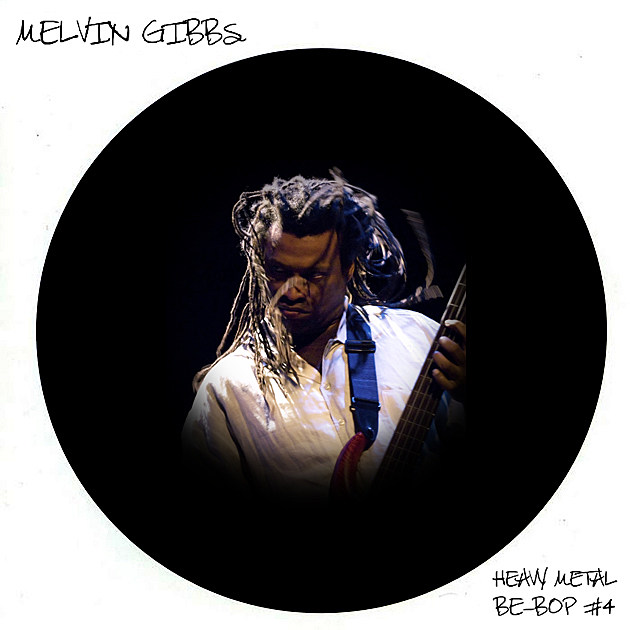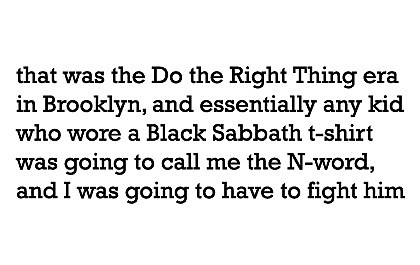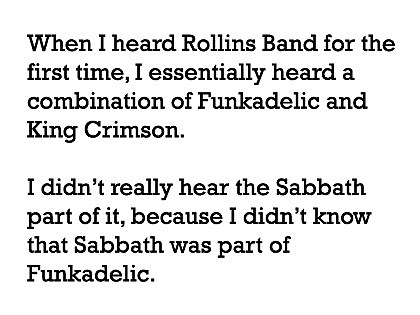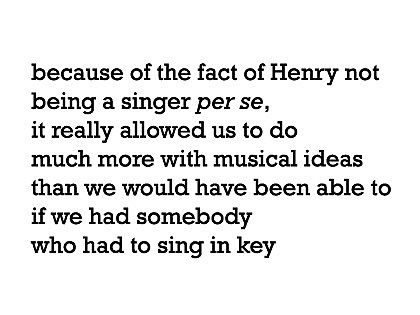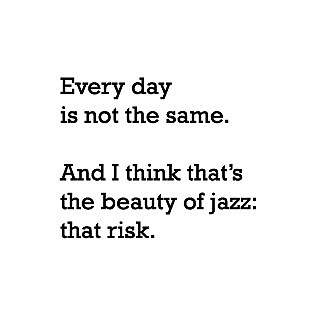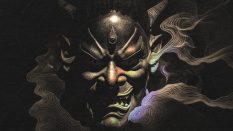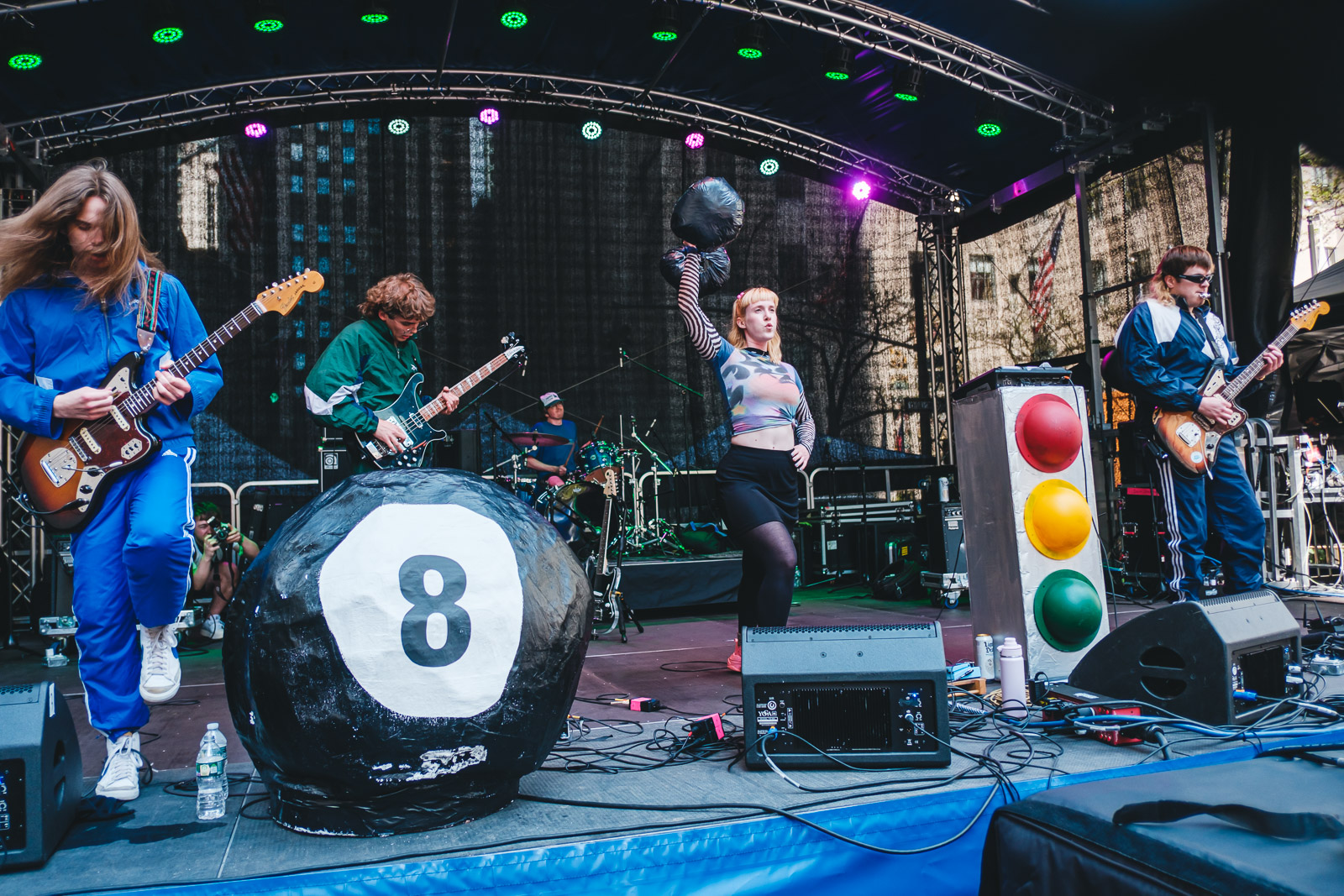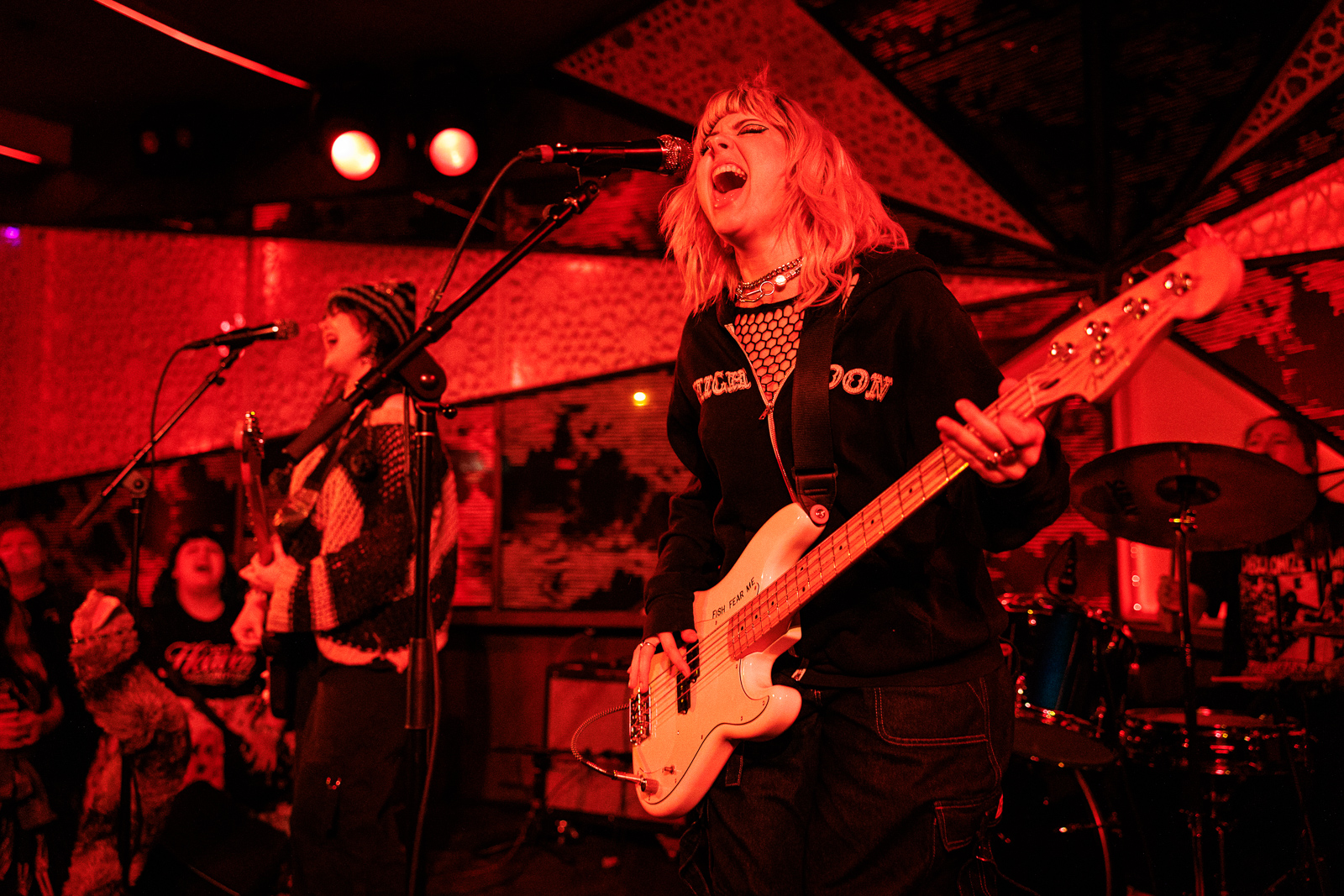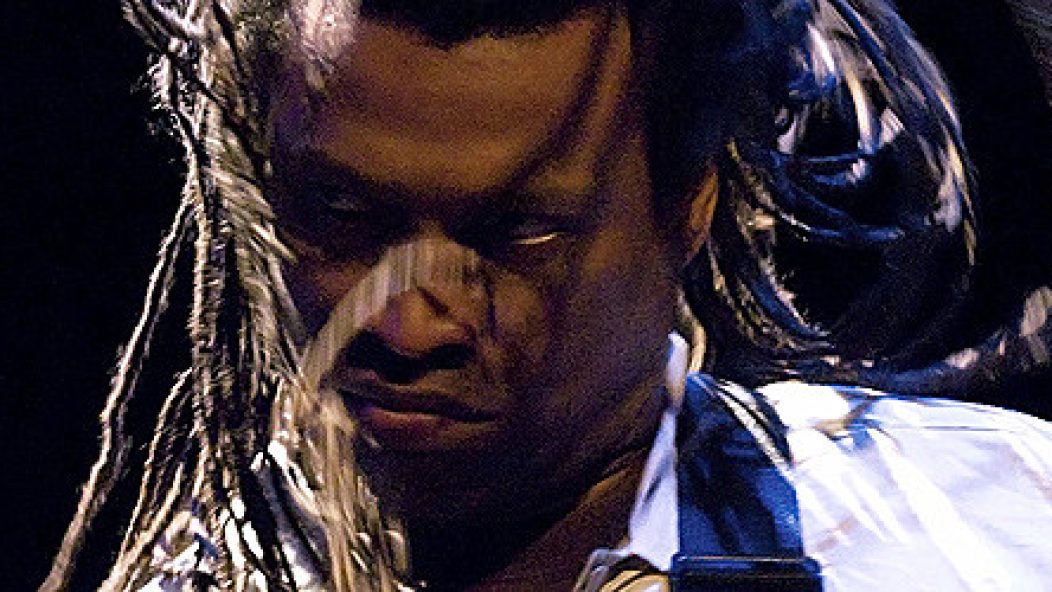
Heavy Metal Be-Bop #4: Interview with Melvin Gibbs
. . .
Melvin Gibbs has a badass résumé. A bassist who has performed with both hardcore icon Henry Rollins and avant-jazz guitar dynamo Sonny Sharrock is someone to pay attention to. Together with longtime friend Vernon Reid (Living Colour’s guitarist), Gibbs came up in drummer Ronald Shannon Jackson’s Decoding Society, the wildest fusion band of the ’80s. Later, he anchored the Rollins Band during the art-metal juggernaut’s 120 Minutes heyday (Woodstock ’94!). He’s also worked with Funkadelic’s Bernie Worrell, DNA’s Arto Lindsay, roots-jazz master Bill Frisell, electric–Miles Davis collaborator Pete Cosey, the atmospheric power trio Harriet Tubman, and his own eclectic African-diaspora survey Elevated Entity. As you’ll see in the following conversation, Gibbs has no trouble connecting the dots between George Clinton and Black Sabbath, Sunn O))) and Sun Ra.
. . .
When we first emailed about this interview, you wrote that you were more of a prog and hardcore guy than a metal guy. How did you get into those styles?
Well, the big joke of the Rollins Band was how little I actually knew about rock music, and metal in particular. One of the reasons was, when I was growing up, that was the Do the Right Thing era in Brooklyn, and essentially any kid who wore a Black Sabbath t-shirt was going to call me the N-word, and I was going to have to fight him. So that was my association of heavy metal music – a bunch of racist dudes that I was going to end up in a fistfight with. So I never actually listened to it, Sabbath in particular, for a while. Later I found out that they actually are a really great band, but at that time I didn’t really listen to them.
The guys I grew up with, we were funk heads, but it expanded out into jazz fusion and bands like Mandrill, King Crimson, Yes, because that’s my age; I’m from that era. And the spin-off bands like U.K., Tony Williams Lifetime with Allan Holdsworth in it, and early Genesis. I didn’t really listen to Zep or Sabbath. I actually got into metal in the ’80s when I was working at Tower Records. I’d just hear stuff when I was walking around in the store, and I’d go down to the rock floor. I was listening to something – I don’t remember what it was – and I was like, “I really like this!” And the guy that was working there was a real metalhead, and he was like, “Man, that’s poseur music. I’m gonna make you a tape of some real metal”. And the tape was Venom, Slayer, Voivod, early Metallica. And then I just kind of glommed onto that stuff.
But the hardcore thing actually goes back to Gil Evans’ son. He’s the one who actually got me into it. At that time I was playing with a good friend of mine who has since passed, Alphonia Tims. He had one cassette out on ROIR. Alphonia was pretty seminal to my development as a musician because Alphonia became Ornette Coleman’s protegé, and we used to rehearse at Ornette’s house, and Ornette kind of schooled us. And at some point, he and Ornette had some kind of weird falling out; I don’t know why. And then the next time I heard from Alphonia, he called me to come rehearse at a place called Westbeth, which is an apartment complex on Bethune Street in the Village. We were rehearsing, and this old dude comes in and watches rehearsal for a while. At the end, he tells us how great the music was, and Alphonia says, “Oh, Melvin, by the way, this is Gil”. And that’s when I realize, this is Gil Evans. Alphonia went from Ornette to Gil Evans. So we went upstairs the first day and I met the sons, who are great guys: Miles and Noah. Miles is running the Gil Evans band now. Miles plays trumpet; Noah plays bass. I haven’t talked to Noah in a while now, but he had a recording studio.
. . .
. . .
Anyway, after being around there, the routine would be that we would rehearse, and then we’d go hang out with them. And I guess the second or third rehearsal, I went up there and hung out, and Noah’s like, “You gotta hear this music!” And he pops this cassette in, and I’m just kind of like, “What the heck?!?” It was the Bad Brains’ first album, and it hadn’t even come out yet. He had an advance cassette of it, and I was just floored by this music. I don’t know if it was Noah who had the tape, or Mackie who had the tape, but Noah introduced me to Mackie that day, who he was in a band with. At that time, Mackie was the drummer for the Cro-Mags, and he later became the drummer for the Bad Brains. So those guys were my introduction to that whole scene of music, and I was an instant Bad Brains fan after that and still am. And I listened to a bit of the Cro-Mags because Mackie was in it, and I started listening to the New York hardcore bands. The scene was cool, but it was just that the Brains thought more like we did (laughs), because I later found out that they were a fusion band first, which is the same sort of thing that me and Vernon Reid were coming off of. So that music was more interesting to me. And from that thing, that led me to bands like Slayer, which was kind of like the next level of that. So that’s where my head was.
And then I didn’t get into the really old-school metal until I joined Rollins Band, and I actually had to listen to Zep and some of the more modern bands of that time. Henry was a big fan of Sleep, so we used to listen to Sleep all the time. I was actually more of a stoner guy myself. I liked, like, Monster Magnet (laughs) and Kyuss, which the rest of the guys couldn’t stand. That was more my head. I mean, Metallica’s Metallica – you gotta love Metallica. Slayer’s Slayer – you gotta love Slayer. For that time, it was incredible music. But I also really liked what Public Enemy was doing with sampling and making this kind of noise thing out of it. And pretty much after I left the Rollins Band, I stopped following metal as heavily. I still kept up with some of the stoner bands, because I just liked that form of music for whatever reason. And then running around with the arty-fartys, they kind of got me into Sunn O))). I mean, you gotta love Sunn O))). It’s interesting for me because when I first hear them, I thought, “This is just some grunge to the nth degree”. And I found out later they’re actually from Seattle. That real droney thing, on a certain level, it’s not that far from Harriet Tubman [the band]. It’s more aggro. And I heard Black One, and I was hearing some other stuff on there, and I found out Oren Ambarchi had played on the record.
. . .
And so you’ve worked with him?
No, I met Oren when I was in Rollins Band, and he actually told me that that band he had back then, Phlegm, they were big Power Tools fans, and we talked a bit. We kept in touch back then, but I’m gonna reassert that connection at some point. I’ve always wanted to figure out something to do with him, because I really like the way he approaches adding the elements he adds into the music. I’m gonna figure out something to do with him in the next couple of years.
So when you started getting into the stoner stuff, as you put it, did that prompt you to get back into the Sabbath that you’d dismissed earlier?
No, playing in the Rollins Band got me into it. When I heard Rollins Band for the first time, I essentially heard a combination of Funkadelic and King Crimson. I didn’t really hear the Sabbath part of it, because I didn’t know that Sabbath was part of Funkadelic in the first place. That’s where half of Funkadelic comes from: Sabbath. “Standing on the Verge [of Getting It On]” has that little “Iron Man” chord in there. So I kind of had to go back and do my homework on what Sabbath meant to that whole era. That band spawned a gazillion different bands. Even to this day, the newer bands, they still have elements from what Sabbath was doing back then. It was directly because of joining the Rollins Band that I started listening to the more old-school stuff. Otherwise, I probably still wouldn’t have. To me, the flatted fifth and all that stuff – that’s Coltrane. That’s where I got it from. And you know, the Bad Brains, that’s the same place. That comes from the jazz side. It doesn’t come from the devil-music side.
You mentioned the connection between Bad Brains and fusion. Obviously there was also the SST stuff, in terms of hardcore informed by jazz.
Yeah, Greg Ginn was big into trying to fuse those elements, and that’s why he got Andrew Weiss and Sim Cain in Gone, because they could play both sides. I’ve never actually talked with Ginn, so this is secondhand info, but all those guys were big free-jazz heads, and everybody’s a big Pete Cosey head. It’s like he’s the meeting point of 50 different styles of playing (laughs). Yeah, trying to combine a lot of the things that Pete did with the more expansive rhythmic stuff that the rock guys brought in. And Sonny Sharrock, too – he’s also a very large influence to that music.
So you had a sense that people like Sharrock and Cosey were feeding directly into that type of hardcore?
I can tell you what Sim and Henry told me. Sim played with Greg, and that’s what he told me. As far as Pete, I mean, Arto Lindsay will tell you that he was a big influence on the No Wave guys. As far as the hardcore guys themselves, you can definitely hear the John McLaughlin influence in there. It’s not a mystery (laughs). And like I said, with Rollins Band, King Crimson was a big part of it. You could almost pick out riffs sometimes.
. . .
Encryption (Melvin Gibbs, Vernon Reid, Ronald Shannon Jackson)
“Blood Life” (live @ Moers Festival, 2011)
[audio: ENCRYPTION_BLOODLIFE.mp3]
. . .
I was watching an interview with you where you were talking about studying jazz with Reggie Workman, and you just mentioned your ties to hardcore. When did fusion come onto your radar?
Well, that was what we were doing. That’s just what we were playing when we were kids. There’s a guy that a lot of musicians know about that a lot of people in the wider world don’t know about because he didn’t really get captured on record properly: a guy named Arthur Rhames, who was from our neighborhood. He had a fusion band called Eternity before he started playing with Rashied Ali and all of those guys. And he was a major influence for all of us in the neighborhood, particularly me and Vernon.
We would go and watch them play or listen to them rehearse, and it was straight-up Mahavishnu-esque fusion stuff, and that was what we were interested in at a certain point. I mean, I grew up in Flatbush, so I listened to the music that somebody my age in Flatbush would be listening to, from reggae to funk to early dance music. But what I was interested in playing was instrumentally challenging music, which at that point was fusion. There was a point where I stopped liking the sports aspect of the music (laughs), if I could put it that way, and I started looking for something a little more musically interesting, and I kind of fell into playing with a bunch of the St. Louis avant-garde guys. And then I fell into playing with this group in Harlem with this guy who was the percussionist for Ornette, and he had Bern Nix in the band, and from hanging with Bern, I started opening up into some other music, and I was able to make part of the connection. And Alphonia introduced me to James Blood Ulmer, and I started hanging around Blood’s house, and that’s when I started to feel like musically I was going somewhere. Simultaneously with that, I fell into playing with James Chance. I don’t remember how I got in with James; I guess Joe Bowie must’ve recommended me. That led it back into the funk thing, and everything connected back up again at that point.
To go back to your main point, which is the connection between fusion and metal, for me, I was really interested in the combination of the facility and the sonics of it. I just loved that harder sound, the aggression. That’s what really interested me.
. . .
Yeah, in doing this research, I’ve been thinking a lot about how the early music that’s called fusion, like the Mahavishnu Orchestra or first Tony Williams Lifetime, does have a real noise and aggression and edginess to it that got filtered out when it moved into what you called the “sports” aspect of fusion.
It got filtered out, yeah. And as far as the Lifetime thing, I was actually in whatever was going to be the last version of Lifetime, before Tony passed. We did a bunch of rehearsals. We didn’t get to talk too much about the actual music, but we did a set of rehearsals that was me, Tony, Brandon Ross, Ronnie Drayton, and Marc Anthony Thompson on vocals. For business reasons, the band didn’t happen. This is while I was in the Rollins Band, and Tony shut the band down for a while. I talked to him about it just before he passed, and he had straightened out his business stuff, and he was ready to do the band again. Then life intervened, or should I say the end of life intervened; it didn’t happen. So that circle was getting ready to be connected back up again.
Yeah, as far as what people call fusion, it’s almost like once you put a name on something, it’s already over (laughs). Once it became fusion, it was dead. As people developed the music, it became more and more baroque to the point where it was about what people could do on top of the music, as opposed to what the music itself was about. And for me, that music came out of a time; it came out of an era. It came out of that early-’60s combination of politics and spirituality, that meeting point where people were trying to be free, and they were trying to find God at the same time – same place that free jazz came from. But then as it evolved, it became more about a presentation, and it became less interesting. But then you had the stream of people who were actually trying to say something interesting in their music. Ornette picked that particular stream back up, and then you had the whole loft-jazz thing that was an extension of the free-jazz thing. But for me, as a guy who was playing an electric instrument, and all of us who played electric instruments, there was a certain resistance to what we were doing that Ornette didn’t show. So that was kind of the entry point for a lot of us, in terms of “OK, we’re going to come in through here“, or through Blood [James Ulmer], or through Ronald Shannon Jackson, or whatever. That’s kind of how we all ended up in that little thing.
. . .
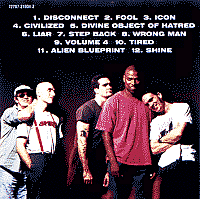
. . .
I wanted to talk some more about your personal history. Preparing for this interview, I watched a lot of clips of Ronald Shannon Jackson, Sonny Sharrock, and Henry Rollins, and I’ve been thinking about the energy of performance that’s there in all those people. Can you describe what it’s like to be onstage with artists like that? Is there a unifying factor?
Well, the thing that you have in common with Henry and Sonny is that when Henry’s onstage, when a gig is over, there’s nothing left. Henry gave 100 percent every night I was with him. I never felt like, “Wow, what happened?” It was always like, whatever he had, you got all of it. And that was the same with Sonny: When we went onstage, whatever he had, you got all of it. There was no holding back. And same thing with Shannon and the drums. When he stepped up and started playing, you better fasten your seatbelt, or you’re going to get thrown off. He’s just coming full power.
And that’s the main thing they had in common: once they stepped onto the stage, or once they engaged with some music, that engagement was 100 percent. And, of course, the fact that Rollins doesn’t “sing” per se, put a whole other thing in what he had to get across with his voice, which was definitely a continuum with what Sonny was doing as far as what he was getting across with the guitar. The whole idea of putting distortion on a guitar in the first place is trying to get past the sound that comes out of the guitar (laughs). You’re trying to send it past that to something else, and that’s the same thing that Henry did. It’s like, “He’s not going to sing; he’s going to come right at you”. Same thing that Sonny did. I mean, Sonny would always start off with these really beautiful pieces, but he was going to come right at you. And the same thing with Shannon. He would start off with something, but then he was going to come all the way at you.
. . .
Yeah, I know there’s that famous Sonny Sharrock quote where he’s talking about “the terror and the beauty living together in one song”.
Yeah, that’s pretty much what Sonny’s thing was. He would tear apart whatever emotion he had set up. He would have this thing that was kind of a “nice thing,” and then he would just split it up into these fragments and put it back together again. We could just take it as far as we wanted. I remember the second or third time I played with him, I was just like, “Let me see what I can get away with”, and I was just doing all kinds of ridiculous stuff on the bass, just to see how far I could take it (laughs), all these weird noises. And he would just look at me, and he was like, “OK”. As long as I was going for what I was hearing in the moment, related to what he was doing, it worked.
The most important thing [with] Sonny is it really freed me me up into what I wanted to do with the instrument. Because that was the era when everybody was still thumping and all of that stuff, and I really had wanted to stop doing that and go back to exploring things like distortion and effects. Because that whole mid-’80s period, everybody was into a real boring, clean sound – the post-Jaco Pastorius era. It was really difficult to really explore anything other than a certain stereotypical set of sounds then, and playing with Sonny, I just decided to go back to what I really wanted to hear. So I pulled out the distortion pedal, pulled out the delay. I really kind of developed the other part of my style that I use most of the time now playing with him because it didn’t matter to him (laughs). I could just play the way I wanted. He wouldn’t freak out that I wasn’t thumping on the bass, or that I was playing a chord. He would just let me play, so I opened myself up to most of what I do now, because that’s how he was.
He was exploring all of those things: He would explore a really beautiful sound and then kind of crash it. And then he could take the crash thing and show you how to bring it back. I can’t say enough good things about Sonny, as far as what he was doing musically, in terms of the emotional continuum. I mean, the whole point of heavy metal is you’re trying to get a certain emotional energy across, and you need to explore a certain set of sounds to get that emotional energy across. And because Sonny’s music covered such a wide emotional area, I was able to throw a whole bunch of stuff in there that might have seemed out of context in other circumstances, and he was very supportive of that.
We had played in Amsterdam on the Sonny Sharrock tour, and I found out later after I joined the Rollins Band that Andrew Weiss (Rollins band bassist before Gibbs) had actually gone to the gig. And Andrew had told them, “Wow, there’s this amazing bass player, playing with all this distortion”, because Sonny just let me do what the heck I felt like. And it was funny: when I actually heard the Rollins Band for the first time, I was kind of like, “Who is this guy who plays like me?” (Laughs) I’m sure he thought the same thing when he heard me. It was getting to the same place, but he came from here, and I came from there, and we kind of met in the middle.
. . .
Gibbs w/ Sonny Sharrock, live ’88
. . .
When you were talking about how the bass sounds got really clean in the ’80s, I was thinking about the progressive-rock bass continuum, the tones that you hear with Chris Squire, John Wetton, and Van der Graaf Generator and stuff like that. The bass was so raw and monstrous then.
Well, it’s interesting, because when we started off, that was always the argument in the hood: Larry Graham versus Chris Squire. And there was a bunch of guys who had [Rickenbackers] and a bunch of guys who had Fenders, and I was on the Fender team. But you’ve got to remember: Larry Graham used distortion a lot in Graham Central Station. [On] “The Jam”, even going back to Sly and the Family Stone he used distortion. For me, he’s more the influence for using those kinds of sounds than Chris and those guys were, who I love as musicians and I love their music.
But sonically, I was never really a Rick guy. I grew up in Brooklyn; I grew up around Jamaicans. I like super-thick bass (laughs), and that hubba-hubba sound is the opposite of that. So it took me a while to actually find the instruments that gave me the sound I wanted, so I went through that whole process of finding instruments that could have a fat sound and still cut through the way a Rick does. That was a long process, actually, but once I found the instruments, then the thing kind of fell into place. But it took a while, honestly, and it took a bit of confidence for me to just really let go of slapping and all of those things.
. . .
I wanted to talk about the transition between what you had done before with Sonny and Ronald Shannon Jackson and the Rollins Band. When you were talking about that idea of, when you were playing with Sonny, taking something pretty and ripping it apart, the first thing I think of is a song like “Liar”, how that concept was happening in the Rollins Band, too. I’m just wondering what it was like to come from that background into the Rollins Band.
Well, I had my own rock band, a band called Eye & I. So that was the transition, but I always remember this thing, reading about Coltrane, him playing the horn and getting to the point where he just wanted to take the horn out of his mouth and start screaming, because the horn had gotten to the end of what he could express, and to me that’s a good analogy of this progression from Shannon and Sonny. “OK, so you said this, but the next point is, you’ve got to just scream it” (laughs), and that’s what Henry is doing.
And as far as these aspects of the terror and the beauty, and definitely as far as the the “Liar” thing, that was something that was consciously thought about by those guys. The musical part of “Liar”, that was pretty much Chris Haskett’s baby, but it was definitely a thing of him combining this really soft element and then putting it into this (mimics screaming). It’s funny how history is, because that was just the year when that was in style. If we had done it a year sooner or a year later, nobody would’ve given a damn. But because that was what was in style that year, that worked on a pop level. But yeah, it’s definitely that exploration on that tune. There’s a couple other tunes where that got explored, that dichotomy type of thing. But Henry was really much more interested in a real firm thing. In a certain sense, that was almost an exception. We got a couple of exceptions in there, and that was one of them.
. . .
As far as the role you played in the Rollins Band versus all these situations you had been in previously – whether it was Sonny Sharrock, where you could go wherever you wanted, or Power Tools where once the improvisation began, it was such a free environment – what was it like being in this very clearly defined bass player/rhythm section role in Rollins?
(Slyly) Well, that’s interesting. That’s one of them chicken-or-egg kind of things, in a sense, because we defined the role, and as far as what I was playing, I was playing what I play. I didn’t play any differently in the Rollins Band than I would play anywhere else. I might move around more musically if the situation musically is moving, but I pretty much played the way I play. It was much more a question of, because of the fact of Henry not being a singer per se, it really allowed us to do much more with musical ideas than we would have been able to if we had somebody who had to sing in key, and we had to put this chord into that chord. We smashed a bunch of things together that wouldn’t necessarily have gotten smashed together.
Having said that, there’s the issue of, you gotta put the thing in a box. It’s got to be a product, for want of a better word. I always felt like that’s one of things I brought to the band, and that comes actually from being in the Decoding Society, where we would have these situations where we would go on tour and we’d play these songs for 10, 12, 15 minutes, and then we’d go into the studio and we’d have to play them in four (laughs)! So one of the things I learned was how to put those ideas in a box. You learn what things are important to make the statement work, and that was one of the things that I felt I was actually bringing to the table with the band. The thing that was great about the Rollins Band – one of the things that was great; obviously Henry was great – but one of the things that was great about the musical part of the band is that they would just play. Rollins Band would go and play a song for 10 or 15 minutes. They didn’t give a fuck. And they would really explore. It wasn’t that far from what Sonny was doing in a certain way.
You’re talking about the Rollins Band before you joined?
Yeah, the band before me. But fitting it into the box maybe wasn’t something that was that interesting to them. But because I came from a circumstance that was the exact opposite, where everyone was always trying to fit something into a box, I had learned how to take these things that were really these extended things and kind of edit them down. So to answer your question, I think that that’s what it is. The fact that I knew how to edit things down made it seem like it was this kind of structured thing, but the structure itself was still the same structure I would use with anybody else. It was just that I knew how to put it in the box and fold it up and make it look like something that you’d buy in a store, but it was still the same thing that you would’ve heard.
. . .
. . .
It’s interesting that you mention that, because I’ve been listening to a lot of Power Tools, and one of the things I really admire about the record Strange Meeting is that it’s a very concise presentation of 10 pieces of music, and it has that pop concision to it, but within that, the improvisation is so wild and wide open. The fact that it’s these bite-sized pieces makes the record really replayable.
That’s a big thing for me. It’s funny. It goes back to reading this business book, and it goes through all these little vignettes, and they go through this one vignette where the guy’s in business school, and Ray Kroc comes to the school, the guy who used to own McDonald’s. And after the talk in the business school, they go out for a drink, and they’re drinking with Ray and they’re talking crap, and Ray asked them, “What is it I do for a living?” And everybody laughed. “You sell hamburgers!” He said, “Nope, I’m a real-estate agent. Our stores are all in the best locations in whatever town they’re in, and that is really the key of what we’re doing”.
And for me, everybody knows me as a bass player, but I’m really a songwriter. That’s what I’m doing. I’m structuring these things in a way that makes it repeatable. That is a goal. And even if you’re doing something where it’s an extended thing, the goal is to structure it in such a way that people can follow it all the way through to the end. And that’s something that I really feel strongly about. When you’re playing free music, there should be a trail, even if it’s breadcrumbs that the bird comes and eats. It shouldn’t just be that you’re up there, and OK, you’re doing your thing and so what. It shouldn’t be a thing where you’re playing for an hour, and I go to the bathroom, and I come back 15 minutes later, and I’m hearing the same piece of music that I heard when I left 15 minutes ago. It can’t be that – who cares. Then just play for three minutes and go home. If you’ve only got three minutes of music, then you only need three minutes of music, and that’s how I look at it.
In the context of the Power Tools record, we had these pieces of music, and we played them, and we stretched them out. And we could stretch them out more when we played them live, but it was a piece of music: harmolodics. That’s Ornette’s whole thing; you’re harmonizing a melody. You’re not just playing (laughs); you’re playing music! And to me, that’s really important. If I bring anything to this music they call free jazz, that’s what it is. I’m not interested in “free” music; I don’t give a damn about that.
. . .
I was listening to those recordings of the Rollins Band with Charles Gayle, and I think when you’re bringing someone with a free-jazz background into, say, the Rollins Band, it’s always a question of where are you going to meet. And in those collaborations, even when there’s a lot of noise on top, the rhythm section is really holding down a groove.
Did you ever wish it would just explode even more, and that you didn’t have to hold down the groove?
Well, “did I wish that it would explode more” is probably not how I would put that. I think that each set of musicians has its own thing it brings to the table, and I feel like for that set of musicians for that day, that’s what it was. I mean, if we’d actually sat and rehearsed and written 20 or 30 songs, it may have been different. But I mean, that was essentially an experiment in doing something free. We had some very loose structures, and that’s what it was for that day.
That’s the other end of jazz: it’s a day-by-day thing! (laughs) Every day is not the same. And I think that’s the beauty of jazz: that risk. Not to quote Donald Rumsfeld, but you have to work with the army you’ve got, you know what I mean? And that day, that was the army we had. So as far as opening it up more, I mean, we could have, but I’ve got to put my head back in where I was at that point and where the band was. I don’t know how interesting that would’ve been to anybody at that particular time. That’s the thing about listening to music 10 years later. I actually enjoy listening to that stuff. I don’t mind that it kind of rambles (laughs). I think it’s a good document of that point in everybody’s lives, and I wouldn’t say more about it than that.
. . .
Do you have any recollections of that session? That must’ve been a cool room to be in, with both Charles Gayle and Henry Rollins.
Yeah, it was great. Henry was really interested in what was going on on the Lower East Side at that point. I don’t know if you remember, but he put out a Matthew Shipp record at that point. And we were all living in New York. I was living on Orchard Street at that time. We were just all around the neighborhood at that time. It was just part of what was going on for him. That’s just part of the cultural thing he was in at that moment, so he just got into it because he did. And he and Charles did a bunch of gigs either duet or trio with Rashied (one example), so I think he felt a kinship with Charles in terms of that thing of “OK, take the horn out of your mouth and start screaming.” (Laughs) There was a definite kinship of energy they were trying to get across at that time.
So the spiritual part of it felt really good: to have Charles there, to have Henry there, to stretch the boundaries of what rock was supposed to be, to bring this other element in, and even on a more didactic level of, “Yeah, there is a connection between these two. This is a continuum of this; this is a continuum of that. What I was doing with Shannon and what I’m doing with Sim, there is a continuum there”.
It was a great day. I’m trying to remember the particulars. Henry and Charles had worked together before, and they worked together some more after that, and I think Charles came and sat in with us on at least one gig (NYT live review, Helmet/Rollins Band ’94).
Yeah, it was a good vibe; it was positive all the way around. Henry was always a positive vibe. I had a great time working with Henry! (Laughs) The guy’s just a model citizen in a lot of ways. He’s still out here kicking ass. Every day he’s actualizing. He’s giving 100 percent every day. He did the same thing with Charles; he gave 100 percent. And Charles gave 100 percent. And it’s funny, because that’s the flip side of free jazz, because it’s kind of like, that’s what you get if the guys are giving 100 percent. And it becomes an issue of, like I was saying, the issue of taking that thing and making it a product. I respect the fact that Henry took the challenge on, so vibe-wise, it was really good because of that. And I think it actually helped the rest of Weight overall, because it made people feel more comfortable about diving into other aspects of what the band was doing, so that’s what I have to say about that.
. . .
Rollins Band – “Icon”
http://www.youtube.com/watch?v=YkFfbhHURSc
. . .
Yeah, there’s a song on Weight, “Icon”, where toward the end it gets into some really abstract stuff. Was there a lot of that with Rollins Band? You said that before you had joined, the band had done a lot of jamming. Was that happening a lot onstage?
They were doing that a lot onstage. I just kind of came in and was doing my thing, but they were already exploring a lot of the same things. I just brought my particular twist and my particular heritage, for want of a better word. But they were playing long-ass songs before I got there! (Laughs) They were playing noise before I got there. I didn’t bring that to the table. They were already doing that. I just brought a certain thought process behind it that hopefully extended it out a bit. But as far as what they were doing, the band was a great band. For that era, I feel pretty comfortable saying that that was the best band of that era, live. You can say what you want about the records. But I challenge anybody from any band of that era and ask them about the Rollins Band, and they’ll tell you that. And part of it was because the guys weren’t scared to go that far out there if they felt like it.
So you felt like Rollins Band was an easy fit for you overall?
Yeah, it was an easy fit, because like I was saying, the midpoints where it came together were the Funkadelic and the Crimson. And because of my slightly different take on what they were doing, I was able to bring in something that wasn’t repetitive to what they had already explored. So it made it fun for them, and it made it fun for me.
I remember when I finally decided to go play with the guys. The End of Silence was actually one of my favorite records. There’s a couple songs I used to listen to constantly, and I was just in the house fucking around, a couple weeks before. “OK, so I’m going to go play with these guys. Let me think about it, just kind of fuck around a little bit”. And I worked on a couple of riffs, and the first thing we played is the riff that is the song “Civilized”. That is literally the first thing we played. I started playing it, they hopped on it, and it stayed in the repertoire from the first day! (Laughs) It was a good fit. And then Chris threw a couple of things out that also ended up on the first record. It was a very beautiful thing. It doesn’t happen that often when you jump up and play with somebody, and you’re like, “This shit is really working”. And because Andrew is such a great musician in his own right, there was a lot of skepticism when this new guy came in. There were quite a few situations where we’d be playing, and I’d see people on the side of the stage just kind of like, (impressed) “Oh, OK”. (Laughs)
Yeah, and even though you had all this heavy-duty experience, a lot of those people who were skeptical probably didn’t know where you had come from.
Well, it wasn’t even just that. I mean, rock bands are very delicate things, man. You can’t just replace a guy in a rock band. But somehow, there was a musical meld between the four of us that worked. It wasn’t the same as what it was, but there was a strong thing that was as powerful in its own way, and people vibrated to it.
. . .
I wanted to ask you about the Melvins thing. You said that at one point you’d talked to Buzz and Dale about joining the band.
Well, that was funny because Eye & I had broken up at that point, and I was kind of just fishing around, and my lady at that time, ironically enough, had been Page Hamilton’s roommate. they had shared an apartment for a long time. And I guess Page was in town for an Amphetamine Reptile showcase, so all the bands were in town, and me and her went and checked it out, and the Melvins was the one that floored me the most.
This was what year?
’92, ’93? I guess if they made a major deal, it was that year. I don’t remember exactly how the connection got made, but I hooked up with Dale and Buzz, and we talked about maybe doing something, but then the Rollins thing came up, and I kind of jumped over, because the thing with Sim and Chris was just so magical right away.
But I love those guys, and I think time has been very kind to those guys. Joe Lally from Fugazi called me to come play with him when he was opening for the Melvins [in Brooklyn in October ’06]. Man, that was killing! That was one of the best shows I’ve seen. I was just floored by those dudes. 20 years later, the music is still valid. I was just happy to see it. it was great. What those guys were doing, it was like time had stood still for them. It wasn’t like they were some old guys. it wasn’t old music. They could’ve went up there with any of these new guys and just knocked them out of the box.
. . .
. . .
Going over your discography, I was thinking about the list of guitarists you’ve played with…
(Laughs) It’s a pretty intense list of guitar players, right?
. . .
Yeah, that just kept leaping out at me. Talking about this jazz/metal connection, the guitar is the instrument that one is naturally going to gravitate toward. So: Vernon Reid, Arto Lindsay, Bill Frisell, Chris Haskett, Elliott Sharp, Sonny Sharrock, Pete Cosey. What are the similarities that start creeping out when you’re playing with all these different people? Do all these people share something?
Well, let me talk about why I like playing with guitar players. The thing with keyboard players is that the keyboard is a very orchestral instrument. You can do anything with a keyboard, and a lot of times, anything turns into everything. So if I’m playing with a keyboard player, they’ll be in a zone that will be very restrictive. And then on the other hand, you have a lot of guys who are very composer-type of guys; they know exactly what they want. And that’s great, but then there’s nothing to give. You’re essentially an employee at that point.
When you’re playing with a guitar player, it’s a restricted instrument (laughs). They have their lowest note, and there’s music they can’t even play. And because there’s music they can’t even play, that allows space for somebody else to play music that they can’t play, and that’s when it gets interesting, because then you can have a dialogue. Whereas sometimes when you’re playing with piano players, it’s very difficult to get a dialogue, because a lot of them aren’t trained that way. A lot of them are trained: “This thing is an orchestra. I’ve got an orchestra, and I’m going to give the whole orchestra”. I always felt like, “If you’re playing a D, why do I need to play a D? I could just go home”. (Laughs) “What do you need me for?”
And as far as what all those guitarists have in common, all the ones that I’ve played with for any length of time, they have in common that they have their own opinion about how to play the guitar. They’re not playing the guitar like some other guy. Even if you could pick out an influence here or there, they’re going to play the guitar the way they think the guitar should be played. They’re going to say, “OK, this is note that I want to hit; this is the way I want to hit it. I’m not going to try to play like Van Halen on such and such a record (laughs)”. They spent a lot of time thinking about what it is they’re going to do with their instrument, and even if they have some pattern things they do, it’s because they’ve developed them. It’s not because they’re trying to sound like some other guy. When Pete Cosey plays, Pete is going to play Pete.
. . .
Power Tools (Melvin Gibbs, Bill Frisell, Ronald Shannon Jackson)
Live ’88
. . .
With a guy like Sonny – again, Sonny had a very strong opinion about what he wanted to do with his music. Frisell has a very strong opinion about what he wants to do with his music, and that strong opinion, ironically enough, needs to be met by another strong opinion. If I’m going onstage with somebody who knows what they want out of their music, then I have to know what I want out of my music. I can’t go up there like, “Oh, I’m just going to play”. That’s not going to work. I have to give at the same level they’re giving. So I’m always attracted to these guys who have strong, unique styles that even sometimes people might not even get.
I remember in the early days with Vernon, people used to be like, “Who is this guy?” (Laughs). Sometimes people don’t get it, and to me, that’s a positive. It’s like of like, “Obviously he’s saying some new shit, if you don’t know what the fuck he’s talking about”. So that’s the thing that’s really important to me, and it’s also the whole thing of the blues continuum for me. I like playing off a certain rhythmic continuum that goes back to Africa, and you can go back to Africa through the US, you can go back to Africa through Cuba, you can go back to Africa through Jamaica, you can go back to Africa through Brazil. But there’s a certain kind of rhythmic thing that I find interesting that in America, guitar players have it, and drummers have it. In Brazil, percussionists have it. In Cuba, actually piano players have it. But in the US, the guitar players are the stronghold of a certain cultural thing that’s interesting for me to interact with, and that’s the other side of it.
Piano has a different function. Like I said, it’s got that orchestral function. It’s almost a court instrument, whereas the guitar is a street instrument, and that’s more interesting to me, because court instruments all over the world, they’re very codified. There’s a certain way you play. If you’re playing for the king of China, you’re going to play a certain way; if you’re playing for the king of India, if you’re playing for the king of the Bamum tribe in Cameroon, you’re going to play that way, and that way only. But if you’re playing some street stuff, you’ve got to play the stuff that people want to hear. But beyond that, if you can come up with some new shit that people want to hear, then you can come up with some new shit, and that’s one of the things that all of these guys have in common: they came up with some new shit that people wanted to hear.
. . .
Did you ever find yourself playing in the Rollins Band, and Chris’ playing reminded you of, say, Sharrock or one of those other guitarists? Did you find yourself ever drawing those connections in the moment?
Uhhhh (Comically drawn-out)… I don’t know how to answer that. You’d better ask Chris (laughs). I mean, everybody reminds everybody of everybody. It goes back to what I was saying before. It’s not a language unless some things are repeated, so to a certain extent, something’s going to remind me of something else. As far as whether Chris reminded me of Pete, I guess he would take it as a compliment if I said yes, so I’ll say yes! (Laughs) But Chris was Chris. It goes back to that thing of what was working in the moment with that set of guys. I couldn’t relate to Chris that way; I related to Chris as Chris. And I related to the three of us when it was the three of us, and the four of us when it was the four of us, in terms of what was going on onstage musically. Like I was saying, it would be more like Henry would remind me of Charles, or Henry would remind me of Sonny. That would be more the reference point, because I just wasn’t listening to the band that way. I wasn’t processing it that way.
. . .
I wanted to ask you about Last Exit. Obviously you weren’t a member, but because you played with Sharrock and Ronald Shannon Jackson around that time, I’m guessing you had an opinion about it.
(Laughs maniacally) Let me say this… And again, it’s 2011. It’s not 1988. A lot of things have changed in the world since then. And I really respect the fact that Laswell brought Sonny out of retirement and brought him into the music, and I respect the fact that he brought that set of people together and they made that music. Beyond that, I’m not going to say anything (laughs). There’s many sides to what Sonny did, and I really like the Guitar record, which was the record he did before I joined the band, and I like the stuff I did with him; I like the stuff he did with Elvin Jones and Charnett Moffett. Because, again, Sonny is a very strong voice. I didn’t feel that Bill as a musical voice was as strong as those guys. And I felt that the band, as great as it was, I would’ve liked to have heard a little more center – let’s put it that way. It was almost like it needed to be less democratic, somehow.
It’s almost like the interesting thing about jazz bands is that there is a leader. That’s why you can have a band like the Miles Davis group with Herbie Hancock and Wayne Shorter, and it sounded one way when Miles was leading it, and Herbie or Wayne could’ve made a record with that same set of guys, and it would’ve sounded totally different. But if they would’ve went in the studio, and there was no leader, you kind of wonder what would’ve came out, you know? (Laughs) It’s an interesting question, because it’s kind of easy to lob bombs from across the room, and I’m not really into that. But Ask the Ages, the record that Bill made with Elvin and Charnett, was a great document; the Last Exit records weren’t such great documents, in my opinion.
. . .
. . .
You go watch Last Exit on YouTube, and it’s just this amazing outpouring of energy on a physical level, but there’s that issue you were talking about of how do you put that in a box? And the Last Exit record they made that was in the studio, it wasn’t all of them playing together and some of the energy was lost.
Well, again, that is the eternal free-jazz problem. If you’re making something that’s based on energy, then that’s a question of being in a room, and it’s a question of the process of being there. That’s not necessarily going to translate to a document.
Right, it could be a great live show, but not a great record.
Well, it could be a great live experience. It might not even be great musically, but it’s an experience. I didn’t go to any of the Last Exit shows, so maybe as an experience, it was something else. I’m willing to entertain the notion that as an experience, it was incredible. I could see that, because I’ve been in those situations myself, where the document after the fact was “eh”, but the actual experience was pretty incredible.
. . .
Well, we were talking about Sunn O))) before, and so much of that is theatricality of it – filling the room with smoke, and whatever else makes it an environmental thing, and also the sheer volume of it. I was talking about this with Craig Taborn, because Last Exit seems like an elephant in the room when the topic of jazz and metal is discussed.
Ummm… maybe, I mean, I would say the Tony Williams Lifetime with Holdsworth. That was an incredible fucking band, man, all the way around. That band was just killing. It was loud as hell. There were even some of those stupid fusion breaks, but there was just so much music there.
But as far as the theatricality of it, I remember still when I was living with my parents – I must have been 13, 14 – and they used to have this thing, they call it the African Street Fair now, but back then it was called the East Festival; it happened every year out in Bed-Stuy. And I remember one year, Sun Ra played, and that was the seminal experience for me as far as the music (laughs), because it was so theatrical, but it was also so musical and it was so out! It’s like Sun Ra, whatever he did in the privacy of his own mind, he had concocted this thing that was so out that it was in. He had this whole mythology. And Sunn O))) has tapped into that thing, where the mythological aspect of it really supports the musical aspect of it, and that makes it really interesting on both levels. It’s got that weird Dungeons & Dragons thing, the guys with the hoods, and all this crazy crap, but it ties everything in together in a really interesting way. They’re on to something, those guys.
All of those Last Exit guys have done stuff that I love. Let me just repeat my first point: I would have liked to have seen more leadership in that band. That’s what we did in Power Tools: Shannon wrote some stuff, I wrote some stuff, Bill [Frisell] wrote some stuff. That would’ve been more interesting to me, personally.
. . .
There’s a macho undercurrent that came to the fore in Last Exit, which you also see in Sharrock’s solo work, and Ronald Shannon Jackson, too, and also Rollins. I was checking out a Rollins interview where he said something like, “We want to ruin you every night”, and it reminded me a little bit of that macho perspective that Sonny tapped into as well with some of the song titles like “Dick Dogs”.
Yeah, somebody called me the most heterosexual person they’d ever met (laughs), and I was like, “Wow, that was the best insult I’ve ever heard”. Shannon had an album called Man Dance that I played on. So yeah, there’s definitely that testosterone current in there. But for me personally, that’s just kind of who I am; that’s just kind of what my vibe is. I’m not only that. Arto’s music, there’s a lot of other emotional areas that it covers, and Sonny’s music went a lot of places. But the aggression, again, is important. I think it’s a generational thing. Even the guys coming up now, even the metal bands now, they’re not the same. I think it was a question of that time, of our era, of the kind of lives we went through.
Let me say something in a nice way to kind of go back to the Last Exit thing: Rollins Band and Last Exit in a double bill, we would’ve ate them alive. We could’ve did the same shit they were doing and we would’ve ate them alive. And I’ll stand by that. And it’s not because we’re musically better than them, because we’re not. Let’s be real. It’s because the aggression had a focal point, and it kind of didn’t with them, and that was the difference.
. . .
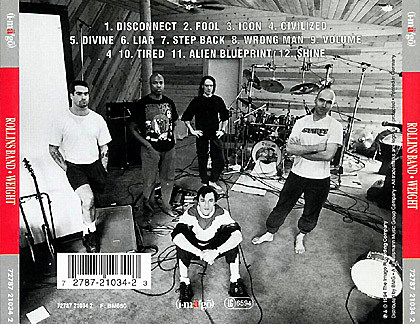
. . .
In terms of projects that have melded the aggression of metal with improvisational excitement, what is the gold standard of that being done, for you?
Wow, that’s a good question. Well, if you’re going to judge them as rock bands or if you’re going to judge them as jazz bands, that’s kind of two different things. I still think that Tony Williams had the best bands, as far as that. The early Mahavishnu, even looking at it on YouTube 30 years later, is an amazing fucking band. John McLaughlin was on to something. As far as something that’s a little more current, there is nothing that I could really say, “Wow.” That’s the interesting thing, because as far as melding those things, I couldn’t pull anything out of my head that I wasn’t a part of! (Laughs)
. . .
Well, even something that you were a part of!
Rollins Band at its more abstract moments, definitely. When Rollins Band would go out there, we would definitely meld the two. Again, that’s what I’m saying, whether you’re going to judge it as a rock band or judge it as a jazz band. Vernon’s doing something interesting with the Free Form Funky Freqs. I guess he’s picking up that thread. We’re all trying to pick up that thread in a different kind of way. But I haven’t really heard a band that I want to hear in terms of melding what I think is metal and what I think is jazz, simply because there’s a few things that have to be solved, which Mahavishnu did solve, and one of them is the rhythmic aspect of it.
You’ve got to think about, when you call something jazz, what does that mean? And the way things went in New York in the ’80s, there were a couple different ways of handling what became jazz. Whether you wanted to call it free jazz or improv, that became one definition, and then you had the whole Jazz at Lincoln Center definition. But I go back to what my parents’ definition of jazz would be. And jazz is music that swung, that you could dance to – and then you’ve got to ask yourself, if you’re going to make something that’s metal, what kind of metal are you going to dance to? And that’s not a sarcastic question, because I used to be down there in the pit. There are ways to dance to metal, but then it becomes the question of what is the swing? If you’re going to pick a swing, whatever you decide that swing is, how do you meld that with your music? And that’s where I haven’t heard anything that I’m really satisfied with. Yeah, Last Exit swung, because Shannon was playing, but the melding didn’t happen in a way that it swung like, I don’t know, Fletcher Henderson did in the ’20s, or something.
There’s a whole bunch of things in the DNA of jazz that aren’t being explored. That’s why I have to go back to Lifetime and Mahavishnu, because McLaughlin’s genius was picking up the Indian thing. He found another way to swing, and he found another way to stick the improv on top of the swing and to make it expand. Tony was all swing, and he found a way to make that swing. I don’t feel like I’ve heard that, in a jazz context. I mean, I’ve heard rock bands that swing, and that’s something I was going to mention.
Again, I’m kind of an old head, but there are a bunch of Brazilian rock bands from the ’90s, in particular Soulfly, the first Soulfly record, where the shit is swinging like a motherfucker. Because he took the Chico Science guys. I don’t know if you know, there was this guy named Chico Science, who was going to be the superstar of Brazil – Chico Science and Nação Zumbi – and they’re from the northeast, and their whole gimmick was they had the northeast traditional drummers, three of those guys, in the band, and they’d be playing along with the rock & roll shit. And Chico was a real charismatic frontman; they would’ve been the shit. Chico died in a car crash.
Anyway, Max Cavalera took those guys, and those are the drummers on the first Soulfly record. To me, that’s a starting point, if you could take some shit like that, and then put some jazz on that. It doesn’t have to be that even, but something that really swings, hard, and then you put some improv on it, then you’ll be talking about something that’s like, “OK, that’s the shit I want to hear”. But I haven’t heard it.
I’ll have to go check that out. I was a big fan of Sepultura.
Well, Sepultura, too. But the thing is, Max took it up to the next level with Soulfly. For me, that was the peak. But even Sepultura, that’s part of it, too, the way he took the tribal rhythms, if you want to call it that, the way they took that rhythmic aspect and put it into metal was interesting.
. . .
It’s interesting, because when you talk about stuff that swings and also has the aggression, I immediately think of Sabbath or Zeppelin, and you had mentioned you were into stoner metal, like Kyuss…
High on Fire, yeah.
Right, and not that anyone’s thinking of that stuff as jazz, but there is that rhythmic imperative of just having these monster grooves.
To me, I need that, and it’s not just because I’m a bass player, though that’s part of it. Because when jazz was made, that’s what jazz was (laughs), music people danced to. People danced to Ellington; people danced to Chick Webb; people danced to Fletcher Henderson. That’s a part of the music. And yeah, bebop came, and the rhythms got really fast and everything became about the virtuosity, and that aspect of it continued on into jazz fusion. But I always ask myself, “OK, it’s 2011. What is jazz now? What does jazz have to offer? What is the idea of jazz?” And you can’t say in 2011 that the idea of jazz is some music from 1950 or 1930. I mean, that’s nice that you want to go hear museum music, but to me, it’s a question of what ideas the guy would be using and how can you apply that now.
To go back to this particular conversation about heavy metal and jazz, I think that swing is the elephant in the room. It’s like, where’s the swing? And it doesn’t have to swing the way Chick Webb swings; it doesn’t even have to swing the way Sabbath or Zeppelin swing, but it needs to be some shit that just makes you… do something. Whether that something is elbow the guy next to you, or kiss your girl, or whatever. It’s got to be something that’s got a kinesthetic element to it. And when I hear something that combines that kinesthetic element with some hard thing, with some improvisational facility that could be considered jazz, that’s when I’ll say, “OK, this is the shit”.
. . .
. . .
. . .
Hank Shteamer writes for Time Out New York, blogs at Dark Forces Swing Blind Punches, drums for STATS, and wrote a book about Ween.
. . .
